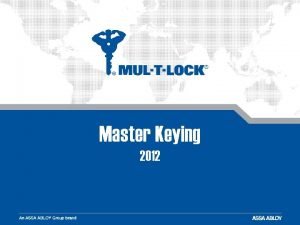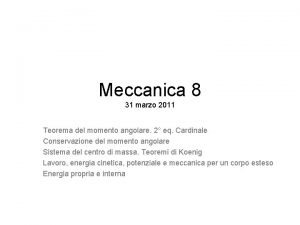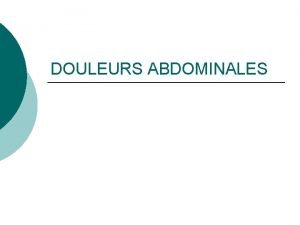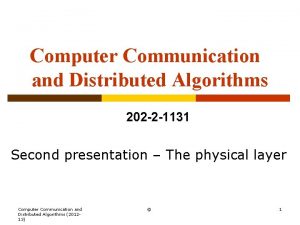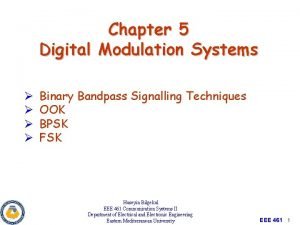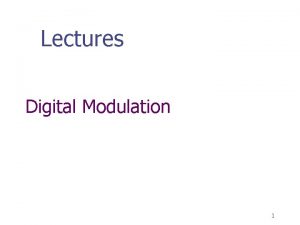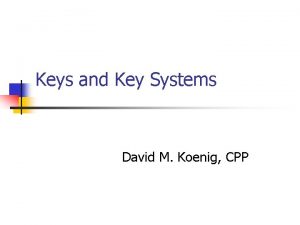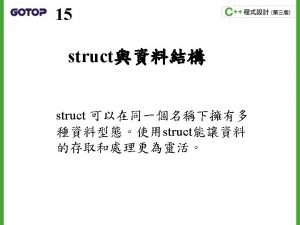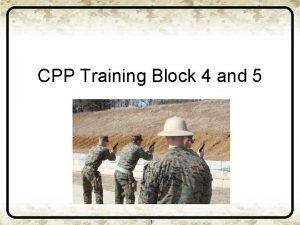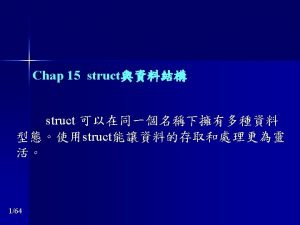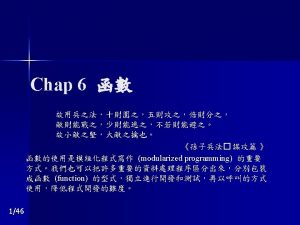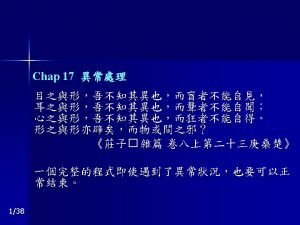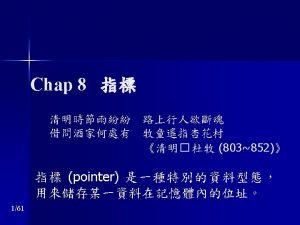Master Keying David M Koenig CPP Master Keying













- Slides: 13

Master Keying David M. Koenig, CPP

Master Keying Is. . . n System Of Organizing Numbers – For Cutting Keys – For Pinning Locks Grouping Of Locks And Keys n Set Of Locks That Are Operated By More Than One Key n

Master Keying Provides Convenience Over Security n Separate Keys For Individual Locks n Keys To Operate Groups Of Locks n Single Key For All Locks In System n Ability To Carry Fewer Keys n Organization Of And Management OF Lock & Key System n

Master Keying Disadvantages Makes Locks Easier To Pick n Small Master Pins Increase Service Issues n Higher Re-keying Cost If GMK Or GGMK Keys Are Lost n More Thought Involved In Administration n Controlled Destruction of Lock Security n

Master Keying Terms KA - Keyed Alike - Several Locks Operated By The Same Key n KD - Keyed Different - Each Lock Operated By It’s Own Key n

Master Keying Terms n CK - Change Key – Work Individual Lock MK - Master Key n GMK - Grand Master Key n – Works Large Group Of Locks n GGMK - Great Grand Master Key – Fits All Locks In System

Master Keying Terms n SKD - Single Keyed Different – Lock Set To Change Key Only n NMK - Not Master Keyed – Similar To SKD n Levels - Number Of Different Types Of Keys In System – Example CK-MK-GMK = 3 Level System

Master Keying Terms n Sectional Keyways - Variety Of Key Blank Grove Sizes And Shapes – Divided Into Groups – Some Patterns Are Wider Than Others – Higher Level Patterns Fit Into Multiple Keyways – Allows Cut Numbers To Be Repeated

System Size and Security 5 Or 6 Pin Chambers (more is better) n Chamber Depths n Pinning Increment (Key / Pin Wear) n How Many Chambers Are Progressed n Angles (Or Other Factor) Employed n

System Size and Security MACS (Maximum Adjacent Cuts) Loss n How Many Masters Employed n Sectional Keyways n

Typical System Example 8 Depths (1 -10 Less Two for MK) n Less Increments of Two n Used In 6 Chambers Equals… n 4 To 6 th Power Equals… n 4, 096 Theoretical Combinations n Less MACS Of 20% n Equals 3, 276 Maximum Combinations n

Medeco Biaxial System Size 4 Depths (1 -5 Less One Number For GMK) n Used In 6 Chambers Equals… n 4 To 6 th Power Equals… n 4, 096 Theoretical n Times 9 Sections (Angles) Equals. . . n

Medeco Biaxial System Size Equals 36, 864 Changes Under Single MK n With MACS Loss Of 20% Combinations (Maximum Adjacent Cuts) n Over 29, 400 Maximum Combinations n Number Of Chambers Used For Master Keys Reduces Maximum And Determines Availability Within A MK n
 Master keying chart
Master keying chart Teorema di koenig
Teorema di koenig Howard koenig
Howard koenig Syndrome de koenig
Syndrome de koenig Frequency shift keying modulation
Frequency shift keying modulation Phase shift keying
Phase shift keying The form and keying style that
The form and keying style that Binary phase shift keying
Binary phase shift keying Qpsk constellation diagram
Qpsk constellation diagram Cpp academic senate
Cpp academic senate Cpp formula
Cpp formula Cpp mechanical engineering roadmap
Cpp mechanical engineering roadmap Radix sort cpp
Radix sort cpp Certified protection professional certification
Certified protection professional certification
